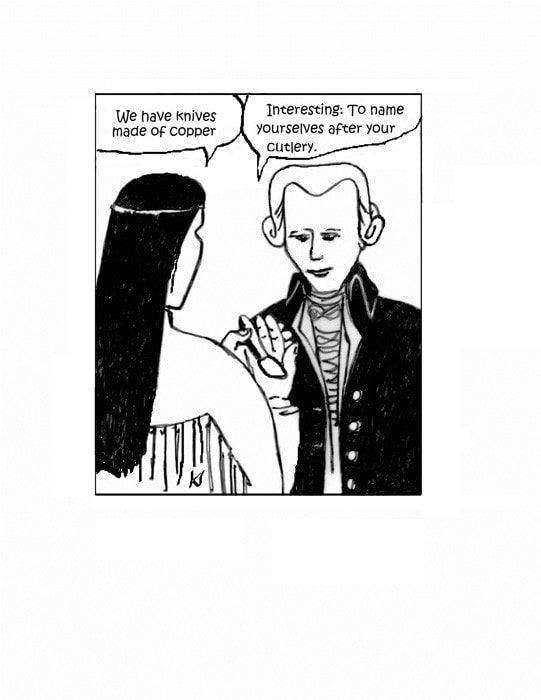by Ruth Bowen | illustration by Kris Schlagintweit
When I saw the ad to volunteer at a remote lodge in the Northwest Territories during the winter season, I almost didn’t apply. I was 56 and surely they would want the young and fit, those able to move mountains of snow and heft a tree on each shoulder? Despite my misgivings, I sent off an email from my home in northern England shortly before Christmas 2009. Two days later, came the reply: “Would it work for you to be with us in Yellowknife Feb 7?”
“Yellowknife!” I shrieked, leaping around my living room. “I’m going to Yellowknife!” What a name! Why / when / how / by whom had the city come to be so named? I planned to write a blog about my travels, and one of the first entries would be on that topic. It would be a great introduction and easy to find out. Or so I thought.
The first page of a Google search “yellowknife name origins” yielded 10 references which all said more or less the same thing:
“The community was established following the discovery of gold in 1934. The name is derived from the Athapaskan band of Amerindians, who possessed tools made from yellow copper. It is now capital of the Northwest Territories, and was incorporated as a city on January 1, 1970.”
(Official Government of Canada website)
But there were differences in those 10 references, a reminder of the perils of internet research. A trip to the Visitors Centre confused me further: I picked up a pin with a little golden dagger, and a card explaining this was the symbol of the city because such knives were used to open dynamite boxes used in the gold mines in the 1930s.
The deeper I dug the more I came up with questions rather than answers. Were the Yellowknives a ‘band’ or a ‘tribe’? Were they really “long gone”? Had those aboriginal inhabitants mined or traded the copper knives and do any such knives still exist today? (I haven’t been able to track any down.) Which of the European explorers gave the name ‘Yellowknife Indians’ to the people living around Weledeh (the Yellowknife River) and Tinde’e (Great Slave Lake): was it Samuel Hearne in the 1770s, Alexander Mackenzie two decades later, or John Franklin in 1823?
The explanation that resonates most strongly for me is on the website of the Yellowknives Dene First Nation:
“Weledeh Yellowknives Elders tell a story in which Alexander Mackenzie decided to call the river “Yellowknife” after what the European explorer thought the people camped at the mouth were calling themselves. Elders today believe their ancestors and the interpreter were actually informing Mackenzie about the copper knives they held in their hands at the time.”

By the time of my third visit to YK in 2012 I had dropped the idea of blogging about the name, but did write an article for The Toronto Star newspaper in which I described staying at a bed and breakfast overlooking Great Slave Lake, “summer home of the Yellowknives Dene First Nation for millennia.” I was loosely quoting from the YKDFN website and a member of the band pointed out that Yellowknives Dene First Nation was formed in the 1990s, so my use of the term “millennia” was clearly wrong. Chastened, I went off to do more research.
I read Weledeh Yellowknives Dene – a history prepared in 1997 by YKDFN Elders Advisory Council. I found it a humbling and inspiring piece of work, and one which I highly recommend everyone read (just Google the title and it is available online). It is many things, including a gripping account of traditional life lived on the land, season by season, and place by place. It describes, in chilling yet unemotional terms the effects of white settlement on the Indigenous peoples, land and animals of the Yellowknife area. It outlines, briefly yet comprehensively, the critical Treaties made between the aboriginal peoples and the government in the early 20th century, and ways those treaties have been systematically undermined or ignored. The history explains that ‘Yellowknife Indians’ and ‘Yellow Knives’ are two of at least 25 names ascribed by European explorers, missionaries and traders to the peoples they found living in the vicinity of what is now Yellowknife; other names include “Copper Indians,” “Red-knife Indians” and “Birch-Rindmen.”
It strikes me as somewhat ironic that in the local aboriginal languages, Yellowknife is not called Yellowknife at all but Somba’ke, “the place of money.”
I still haven’t been able to pinpoint exactly when and how the name given to a people and a river became attached to the city, but I guess it doesn’t really matter. What does matter is what I’ve learned, and continue to learn, about the place I now call home.






